#pentel fade touch
Explore tagged Tumblr posts
Text
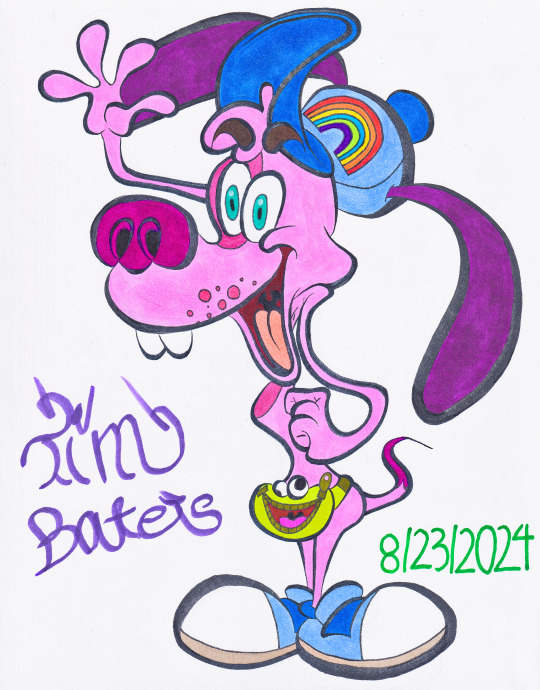
Aye look! It's Bloofy the dog and his goofy-ass fanny pack Pouchy! 🌈
#ohuhu#ohuhualcoholmarkers#alcohol markers#anthropomorphic#fanart#inside out bloofy#bloofy the dog#pouchy#bloofy#fanny pack#inside out 2#inside out 2 fanart#dog#cap#anthro dog#anthro art#blush pen#pentel fade touch#micron pens#shoes#rainbow#canon scanner
9 notes
·
View notes
Text
The Magic of Gel Pens: Smooth, Vibrant, and Versatile Writing

Gel pens have revolutionized the world of writing, offering a smooth and effortless experience with rich, vibrant ink. Whether you are a student, an artist, or a professional, gel pens provide precision, comfort, and an array of colors to enhance your work. Their unique ink formula, which combines the fluidity of water-based ink with the longevity of oil-based ink, makes them a preferred choice for many writing enthusiasts. In this blog, we will explore the history, benefits, types, and best gel pens available in the market today.
The Evolution of Gel Pens
The gel pen was first introduced in the early 1980s by Japanese manufacturer Sakura, which developed a water-based gel ink that allowed for smoother and more consistent writing. Unlike traditional ballpoint pens that use thick oil-based ink, gel pens provide a fluid writing experience with minimal pressure. Over time, major brands such as Pilot, Uni-Ball, and Pentel innovated the gel pen design, incorporating features like quick-drying ink, ergonomic grips, and ultra-fine tips to cater to diverse writing needs.
Why Choose Gel Pens?
Gel pens offer several advantages over other types of pens, making them a popular choice for students, professionals, and artists alike. Here are some of the key benefits:
1. Smooth Writing Experience
Gel pens glide effortlessly across the paper, reducing hand fatigue and making writing more enjoyable. The ink flows consistently without skipping, providing a seamless writing experience.
2. Vibrant and Bold Ink Colors
One of the most appealing aspects of gel pens is their vibrant ink. Available in a wide range of colors, including metallic and pastel shades, gel pens allow for creativity and personalization in writing and artwork.
3. Quick-Drying and Smudge-Resistant Ink
Many modern gel pens feature quick-drying ink, making them an excellent choice for left-handed writers who often struggle with ink smudging. This feature is particularly useful for note-taking, journaling, and drawing.
4. Precision and Fine-Tip Options
Gel pens come in various tip sizes, from ultra-fine (0.3mm) to bold (1.0mm), allowing for detailed work and precision. Fine-tip gel pens are ideal for intricate drawings, technical writing, and neat handwriting.
5. Archival Quality and Water-Resistant Ink
Many high-quality gel pens use archival-grade ink that is fade-resistant and waterproof, ensuring long-lasting documents and artwork. This makes them a preferred choice for legal documents, planners, and artistic creations.
Types of Gel Pens
Gel pens come in various types, each catering to different writing and artistic needs:
1. Standard Gel Pens
These pens are perfect for everyday writing, note-taking, and journaling. Brands like Pilot G2, Uni-Ball Signo 207, and Pentel EnerGel are known for their reliability and smooth performance.
2. Retractable Gel Pens
With a click mechanism, retractable gel pens eliminate the need for a cap, making them convenient for quick use. They are popular in office settings and for students who need a fast and efficient writing tool.
3. Metallic and Glitter Gel Pens
Ideal for creative projects, greeting cards, and artwork, metallic and glitter gel pens add a sparkling touch to writing and illustrations. Sakura Gelly Roll Metallic and Uni-Ball Signo Sparkling Gel Pens are popular choices.
4. Pastel and Opaque Gel Pens
Perfect for writing on dark paper, pastel and opaque gel pens offer unique color options that stand out. These pens are commonly used for scrapbooking, bullet journaling, and decorative writing.
5. Erasable Gel Pens
For those who need flexibility in writing, erasable gel pens like the Pilot FriXion series provide a way to correct mistakes easily. The heat-sensitive ink disappears with friction, allowing for clean erasing without smudges.
6. Fine-Tip and Ultra-Fine Gel Pens
Ideal for detailed illustrations, technical writing, and precise handwriting, fine-tip gel pens (0.3mm-0.5mm) are used by artists, students, and professionals who require precision.
Best Gel Pens in the Market
If you’re looking for high-quality gel pens, here are some of the best options:
Pilot G2: A classic and reliable gel pen known for its smooth writing and long-lasting ink.
Uni-Ball Signo 207: Features waterproof and fade-resistant ink, perfect for important documents.
Pentel EnerGel: Offers quick-drying ink and a comfortable grip for extended writing sessions.
Sakura Gelly Roll: A favorite for artists, available in metallic, pastel, and glitter ink options.
Pilot FriXion Erasable Pens: Allows you to erase mistakes cleanly, great for students and planners.
Caring for Your Gel Pens
To ensure the longevity and optimal performance of your gel pens, follow these simple care tips:
Store pens horizontally to maintain consistent ink flow.
Keep the cap on when not in use to prevent the ink from drying out.
Avoid pressing too hard while writing to prevent ink leakage or damage to the tip.
Use smooth, high-quality paper to enhance the writing experience and prevent feathering.
Conclusion
Gel pens have transformed the way we write, offering a smooth, vibrant, and precise experience for various applications. Whether you're taking notes, creating artwork, or signing important documents, there is a gel pen suited for your needs. With their superior ink flow, wide color selection, and ease of use, gel pens continue to be a favorite writing tool for people of all ages. So, grab your favorite gel pen and let your creativity and ideas flow effortlessly on paper!
0 notes
Text
Affordable Gel Pens for Everyday Writing
Gel pens have become a staple for students, professionals, and hobbyists alike. Known for their smooth writing and vibrant ink, they’re perfect for everyday tasks like note-taking, journaling, or office work. But what if you could enjoy these benefits without breaking the bank? This article explores the best affordable gel pens that combine quality and value.
What Are Gel Pens?
Gel pens use a water-based gel ink that delivers smoother, bolder lines compared to ballpoint or fountain pens. The ink's unique composition makes it glide effortlessly on paper while providing vivid colors.
Benefits of Using Gel Pens for Daily Writing
Smooth Writing Experience: Gel pens reduce strain, making them ideal for long writing sessions.
Vibrant Ink Quality: Their ink appears brighter and more pronounced on paper.
Quick Drying Properties: Many gel pens feature quick-drying ink, minimizing smudging.
Factors to Consider When Choosing Gel Pens
Ink Quality: Look for pens with consistent and fade-resistant ink.
Durability: A sturdy design ensures long-term use.
Price: Affordable pens should still provide good performance.
Why Affordability Matters for Everyday Writing Tools
Whether you're a student managing expenses or a professional buying in bulk for office use, affordability ensures access to quality tools without overspending.
Top Features of Affordable Gel Pens
Comfortable Grip: Essential for prolonged writing.
Refillable Options: Reduces long-term costs.
Long-Lasting Ink: Ensures you get the most value for your money.
Top Affordable Gel Pen Brands
Pilot G2: A reliable choice with refillable ink.
BIC Gelocity: Offers smooth writing at an attractive price point.
Pentel EnerGel: Known for quick-drying ink and sleek design.
Gel Pens for Students
Students need pens that are budget-friendly yet capable of handling heavy note-taking. Brands like BIC Gelocity and Pilot G2 are excellent options, offering durability and vibrant ink.
Gel Pens for Professionals
For professionals, gel pens add a touch of sophistication to meetings and presentations. Affordable models like Pentel EnerGel provide a smooth writing experience without overspending.
How to Buy Affordable Gel Pens
Online Platforms: Websites like Amazon and Flipkart often offer discounts on gel pens.
Local Stores: Check for bulk deals or promotions at nearby stationery shops.
Tips to Save Money on Gel Pens
Buy in Bulk: Bulk purchases often come with significant discounts.
Opt for Refillable Pens: Refill cartridges are more affordable than buying new pens.
Common Myths About Affordable Gel Pens
“Cheap Means Low Quality”: Many affordable gel pens rival the performance of premium models.
“Refillable Pens Are Expensive”: In the long run, refillable options are more economical.
Maintaining Gel Pens for Longevity
Proper Storage: Store pens horizontally to prevent ink clogs.
Regular Cleaning: Remove dried ink from the nib to maintain smooth writing.
Eco-Friendly Affordable Gel Pens
If you're environmentally conscious, look for affordable gel pens made from recycled materials or those with refillable cartridges. These options reduce waste and are often cost-effective.
Conclusion
Affordable gel pens are a fantastic choice for anyone seeking smooth, high-quality writing without spending a fortune. With the right brand and proper care, these pens can meet all your daily writing needs, whether for school, work, or personal projects.
1 note
·
View note
Photo
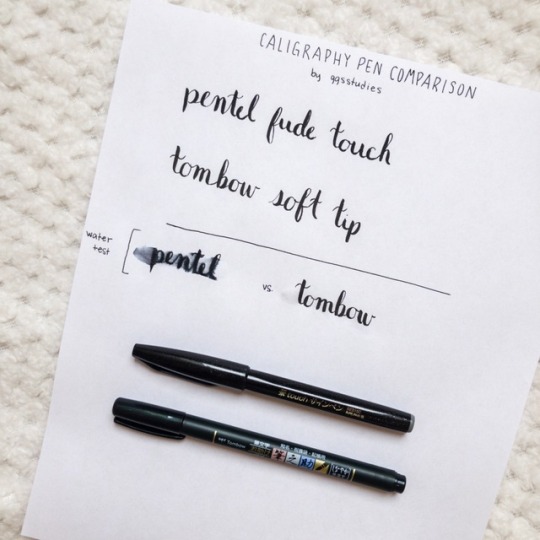
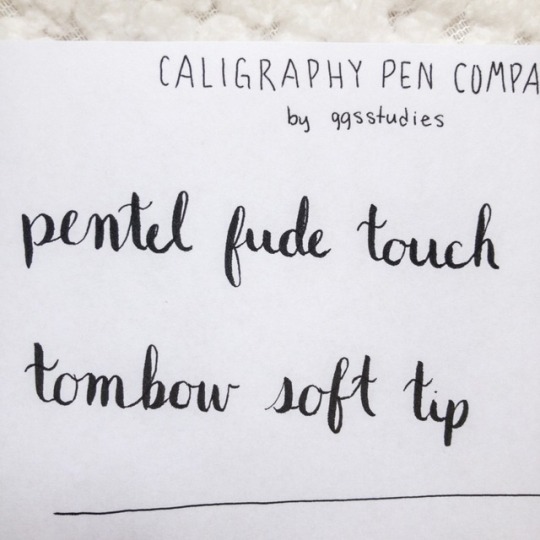
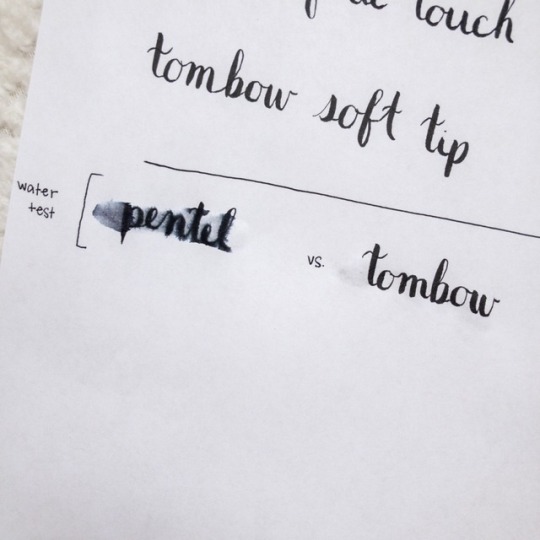
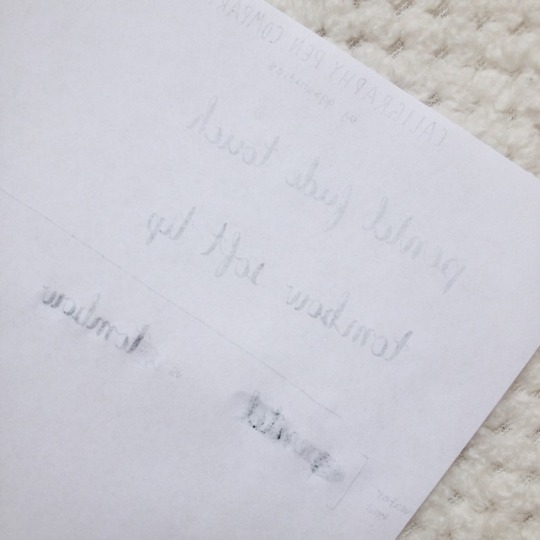
8/5/18
ok so since i’ve gotten these two calligraphy pens (the pentel fude touch and the tombow soft tip) i thought i would do a comparison of the two because they are quite similar. i’m a beginner to the whole calligraphy world so don’t judge my shaky lettering. i’m getting there, slowly but surely.
pentel fude touch- this calligraphy pen is considerably smaller than the tombow and it’s really comfortable to hold. it’s like the perfect size. it’s very easy to write with and it very fluid. the pen gradually gets smaller as you go towards the tip, making it easy to hold. as for the color, it is very very black compared to the tombow (can’t really see in the picture but it’s noticeable in person when holding it in the light. when you add a white gel pen over it (not pictured), the white almost fades into it and you can barely see it. as you can see from the water test (i used approximately the same amount of water (and type) and dragged my finger across the paper starting from the right side and pulling towards the left), this calligraphy pen isn’t any close to waterproof/water resistant. the ink went right with my finger and left some ink on it as well.
tombow soft tip- this calligraphy pen is a little longer than the pentel and i find it a little bit more difficult to grip. it doesn’t gradually get smaller, it’s more of a stair step towards the tip. the black isn’t as black as the other one. however, with this one, if you add a white gel pen over it, the white stays pigmented. in the water test, the tombow totally topped the pentel. it barely smeared when i dragged my finger across it.
so in conclusion, i personally think the pentel fude touch is the way to go for any beginner. it’s very comfortable to hold and flows easily. however, it can’t take a white gel pen on top and isn’t waterproof/water resistant. if you want something more permanent where you can write on top of it with a white gel pen, the tombow is for you.
these were just the things i noticed and i’m only a beginner at calligraphy. i will probably use both of them for my notes because i haven’t decided which one i like better. i hope this was useful :)
xo- gg
#ggsstudies#mine#calligraphy pen#calligraphy pen comparison#comparison#calligraphy#tombow#tombow soft tip#pentel fude touch#pentel#water#smear#white gel pen#supplies#new school supplies#new supplies!!#school supplies#hand lettering#cursive#studyblr#studyspo#study motivation#studygram#studyspiration#study#studyquill#stationery
10 notes
·
View notes
Text
My name is Dominik Neuffer, and I’m from Germany, but I currently live in Switzerland. Maybe you know me from the Urban Sketching Group here on Doodlewash. I started sketching as a kid. My mother was a textile designer and I could learn a few things from her, like our daughters are currently learning from me, by watching and trial and error, of course.
Later, when I was older and more experienced, I also could help my mother every now and then. However after trying to study landscape architecture and lots of drawing and breaking up with it after my mother died, leaving me with a whole bunch of responsibilities, there followed a long hiatus over the years, where I did not sketch very much.
When I started to study computer science and successfully finishing it, I did computer graphics. But, I barely picked up a pen during the best part of ten years. Finally when our oldest daughter told me in 2015 she’d liked to start sketching seriously, I thought, well, that might be a good opportunity to reboot my sketching habit.
Since 2017, also thanks to World Watercolor Month, I’m back at a daily sketching routine. I think I’m a mixed media type. In school, I scribbled with pencil and fountain pen. I also liked crayons. After dabbling a bit on the iPad, the first sketches, I made again, were ink and color pencils. But, I was very fascinated by wet media and soon I bought my first watercolor set from Winsor and Newton.
Currently I’m most of the time sketching directly in document ink and adding washes of color. For ink, I use Sailor Jentle Kiwa Guro ink or Platinum Pigment ink in a Kaweco AL-Sport or Lamy AL-Star, because they‘re sturdy, not too expensive and easy to clean. I also like adding highlights in white with gel pens. Sometimes I throw the good old crayons in the mix or even use brushpens or ballpoint pens.
For brushpens I have a Tombow Calligrapy pen and a few identical Pentel brushpens, I refill with Kiwa Guro as well. The Akashiya Sai color brushpens are also nice for a change. For water soluble black ink for a broad stroke I recently discovered the Pilot Sign Pen.
For ballpoints, just a cheap pack of Bic Cristal from the supermarket. I also use Pelikan Skribtol directly out of the bottle (caution not for the faint of heart) With gel pens I had good experiences with the Jelly Roll and Uni Ball Signo in broad, but a Pentel Correction Pen can be fun as well (also not suitable for control freaks).
As for watercolors, I started with Winsor & Newton Cotman, switched to Prima Marketing and Van Gogh, but am currently most of the time using Schmincke Horadam because of their quality and availability. Also, The Schmincke work well with the old Schminke Gouache I have left from my mother which are still workable after 20 plus years. Sometimes I also use Kuretake Ganzai for plain color wahes.
Paper and sketchbooks, I’ve used a phletora. I really can recommend Seawhite of Brighton Mixed Media, they‘re affordable and can take a few washes of watercolor, but I have used so far with no complaints: Moleskine watercolor (good but expensive), Sennelier, Canson, Talens, Field Artist, Khadi and Pentalic.
For more watercolor work and loose sheets, I currently work with Arches Hot Pressed (satin) which I also use for bookbinding, but I‘ve also had very good experiences with paint on à grain from Canson. I‘m currently still searching for the perfect paper to combine ink work and watercolor or mixed media with crayons.
It was really eye opening when I realized that I’m a sketchbook person. I’m not that good with single sheets of paper. That doesn’t mean I don’t use them at all, but generally not much. I like to keep my visual notes, as I call them, in a bound book. Seeing it filling up day by day is something I find extremely satisfying. Also, keeping the mistakes and looking back at them later is really helpful for getting better, accepting and working on your shortcomings at the same time. As sketching became a daily routine, the motive of the sketch became less important.
If I wanted to get better at sketching, I realized, I had to sketch and not to be picky about what to sketch. The subject of the sketch doesn’t really matter. So, some sketches are really done for the purpose of sketching alone and that can be satisfying on their own. Basically, it really doesn’t matter what you’re sketching when you get immersed and enter the meditative sketching zone.
Most of the time, I like to catch moments and memories, though. For that I set the bar not very high. I like trivial things that become interesting the longer you look at them. Abandoned places, people on the train, old cars, I like to collect as I spot them. Also, living in Bavaria, the typical Swiss architecture is interesting to me. Most locals just fade it out. Since I’m doing this on a daily basis for 18 months now, I’m getting bolder. I’m sketching in restaurants, bars, at reunions and meetings. Just starting with a little scribble can be very beneficial as it opens your eyes and sharpens your senses. All of a sudden you’re starting to see motives everywhere around you.
Most of my work is done on the go. On the train, during lunch break. I enjoy jotting down the things I encounter on a daily basis. For example, when I was taking a short walk after having a quick bite for lunch, heading into a direction, I haven’t been yet, I discovered an old tower from 1542, which served multiple purposes throughout the centuries (prison, storage, sleeping place for soldiers). A nice motive for the 20-30 minutes I had still left of my lunch break.
When sketching from life, I first define the shapes with quick strokes in ink. Sometimes I start with pencil. After that I lay down a few washes of watercolor to define the basic shapes of the composition further. As finishing touches, I often add a few highlights with a white gel pen. When sketching on the go, watercolor is a convenient medium to add color.
For the composition itself, I feel free to move around things or leaving them out. That’s one of the benefits when sketching from real life. It’s more easy to distinguish between the interesting and uninteresting stuff. When looking at a photograph, for me, making that distinction is not as easy. Generally, I try to work my way from the foreground to the background and trying to keep everything in between balanced and interesting, leaving details out where there isn’t my main focus.
I use too many sketchbooks. I’m trying to get the numbers down this year, but there isn’t the perfect sketchbook – at least not for me. Also last year, I learned how to bind my own books, that multiplies the possible combinations of papers and formats. It’s easier than it looks and it can be also a satisfying occupation on its own. You should absolutely try it.
For me, it all started with a sketchbook. I made myself on out of paper, my aunt gave me. Heaps of it. And since I’m not good with loose sheets, that was the perfect moment to plunge into bookbinding. The paper was decent, but nothing great, just right for quick visual note taking without worrying about wasting expensive paper.
When I have more time to sketch, I use better paper, preferably 200 gsm or higher. That’s when I bring at least three sketchbooks with me. Then I might draft the basic shapes with pencil or watercolor pencil as guides for filling in the colors. I also might use a pencil or graphite stick or even a black brushpen or diluted indian ink for adding value before coloring.
After the washes of watercolor, I add contours where necessary with fountain pen and black ink, highlights with a white gel pen and more contrast with crayons if necessary. Sometimes, however, I like to change things a bit and use ballpoint pens or red document ink for the outlines. Also sketching directly with water soluble ink before coloring can be a wonderful and freeing experience.
In 2018, I collected lots of memories that can be revisited by flipping through my sketchbook pages. Like the guys I sketched on the train and showed them the picture afterwards. An especially nice couple, even made a Polaroid of me as a gift in exchange. Another very particular and treasured moment is meeting three retired teachers in San Francisco and being invited by them on a day trip, because they enjoyed seeing me sketching.
Also in 2018, was the wedding of my cousin. During the festivities, I made 12 sketches of the event. That was my present for the newlyweds. For myself, I made five sketches on top of that to remember it. Being the “official” sketcher in addition to the hired photographer, I had a really great time, chats and drinks of course.
Besides that, the most treasured moments when it comes to sketching are the sketching ventures with our six year old. Kids of that age totally immerse themselves into the drawing. Usually, I can only get a quick sketch in while we’re out together, but I do enjoy having a memory of our shared moments.
Then, of course, there is the chatter you sometimes have with likeminded artists who spot you sketching or people who want to try sketching for themselves or start it again. I try to be very supportive when it comes to that, knowing how it made my life more colorful.
Then there is of course the “OMG, you’re so talented, I couldn’t do it” comment. I like to disagree on that with a soft but distinct statement. Because I don’t consider myself as very talented. Kids are naturally talented, but most of us stop sketching when entering adulthood. It’s all about practice and actually doing it.
I’m a fan of grinding. Back in the day when I was playing computer RPG games, grinding meant killing the same small monsters over and over to level up. While playing computer games didn’t teach me much about drawing, one thing I learned was that there can be quite a bit achieved by grinding. Or like the Japanese proverb says “Even Dust, When Piled up, Will Become a Mountain.”
Same goes for drawing. Constant practice makes you better and confident. Don’t venture out and attack the level boss first. Fight the smaller ones. If you’re overwhelmed by complexity, break it down into digestible bits or try something easier. I usually try to start as easy as possible.
Everything mustn’t be great, everything can’t be great, but by sketching regularly you eventually will get better and end up with a few good sketches, even great ones, you can be confident about and show with pride, because you deserve it. You don’t always have to share it. The sketchbook is yours, you can keep it all alone for you and keep it private. But, my advise would be to share at least some of your pages. It’s totally worthwhile.
Don’t try to judge yourself by the work of others. Only you can sketch like you can. Your line work is unique to you. Have fun and sketch often, then you’ll get better inevitably. While sketching from pictures can be good practice and I do it also as a second choice – preferably from pictures I made myself, going out and sketching from life is best in my opinion.
Also working with limited timeframes can be liberating. Knowing I cannot produce a masterpiece in 20 minutes can be a delightful experience. For me that means, getting a scene into my book without having the time to fret about mistakes. And that shows. Some of these quick drafts have a boldness that is hard to replicate when having all the time that would be needed.
Look forward and from time to time look back to see your improvements. Experiment to broaden your knowledge but also come back to the things you love and improve them. That way you’re building a solid foundation and confidence. Always carry a sketchbook with you, because the moment you’d like to catch probably won’t be waiting for you to be ready.
The new year is still young and now is a good time to start a sketching habit. As for my “resolutions”, I’m trying to get the number of my sketchbooks, that are in use, down as I’m trying to complete as much as possible before starting new ones. Also this year is all about reviewing and refining my style.
I’m also very interested in your goals. Let me know about your goals in the comments!
Dominik Neuffer Doodlewash Instagram YouTube
GUEST ARTIST: "Collecting Memories" by Dominik Neuffer - #doodlewash #usk #urbansketchers #urbansketching #watercolor My name is Dominik Neuffer, and I'm from Germany, but I currently live in Switzerland. Maybe you know me from the…
#doodlewash#drawing#featured#sketchbook#Sketchbooks#sketching#Urban Nature#Urban Sketchers#Urban Sketching#watercolor#watercolor sketching#watercolour
1 note
·
View note
Text
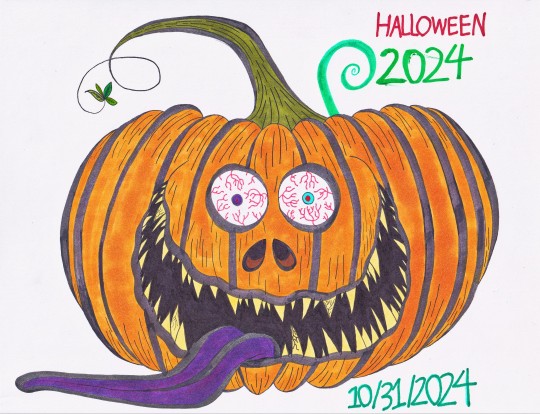
This pumpkin is just brain dead 🎃
#ohuhu#ohuhualcoholmarkers#alcohol markers#halloween drawing#halloween#halloween 2024#jack o lantern#brush pen#micron pens#creepy art#crazy#anthropomorphic#teeth#pentel fade touch
0 notes